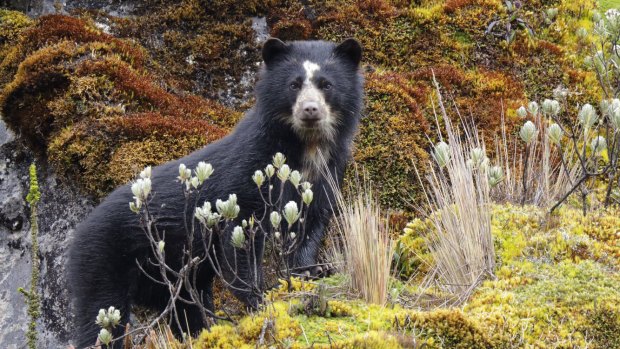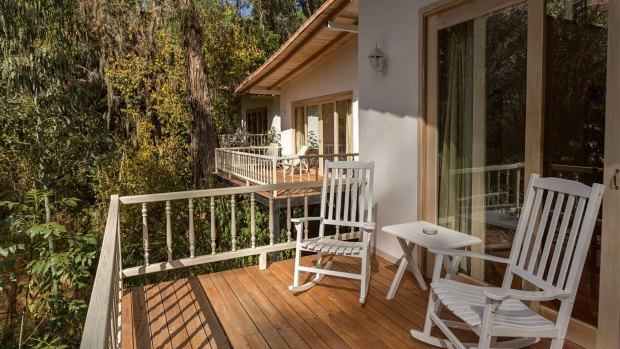This was published 5 years ago
Imbabura province, Ecuador: Where to find the spectacled bears of South America

Although Paddington famously hailed from "darkest Peru", you can find spectacled bears throughout the Andes mountain range in South America.Credit: Getty Images
Danilo Vasquez suggests we train our binoculars on a patch of bromeliads on the opposite side of the valley. Paddington's favourite food may have been marmalade, but the spectacled bear on which he's based is much more interested in the rust-red flowering plants scattered across the steeply plunging hillside.
We wait, slowly scanning the area, while the enthusiastic Vasquez alternates between peering through his telescope and hoisting aloft an aerial that's tuned into a GPS tracking collar worn by one of the bears. He assures us he has a 95 per cent success rate for spotting South America's last surviving native bear, named because of the distinctive spectacle-like beige markings on its face and chest, so the pressure is on.
Although Paddington famously hailed from "darkest Peru", you can find spectacled bears throughout the Andes mountain range in South America. Vasquez's property is in Imbabura province in northern Ecuador, around 120 kilometres from the Colombian border, in a vertiginous region rarely visited by tourists.

Hacienda Piman.
A farmer by trade, he started this project to observe and protect the region's bears, which he says have been visiting the valley for the last 10 years. In the past, local farmers would often shoot bears when they ate their crops; now Vasquez compensates them using donations from tourists and environmental organisations. Despite his efforts, he says there are less than 2000 spectacled bears left in Ecuador and the species is categorised as vulnerable by the International Union for Conservation of Nature.
This bear-watching excursion has been organised by Hacienda Piman, a sprawling colonial property in the foothills of the Andes 130 kilometres north east of Quito. It's one of the country's oldest haciendas, having been owned by the Zaldumbide family since 1680, and it recently emerged from a year-long renovation as an atmospheric 17-room hotel.
On arrival we're ushered onto a covered verandah where sofas and armchairs huddle around a wood-burning stove. Clutching welcome glasses of warm canelazo – a traditional Ecuadorian drink made with naranjilla juice, cinnamon, sugar and aguardiente – we gaze out across a tranquil forested valley.
Once a 24,000-hectare farm growing coffee and cotton, this historic property has shrunk over successive generations to its current size of around five hectares. Located on the original route of the Pan-American Highway, it was once the home of two of Ecuador's best-known writers, Julio Zaldumbide and his son Gonzalo. It also hosted Simon Bolivar, the Venezuelan leader who liberated Ecuador and several other South American countries from Spanish rule.
The seven rooms in the old manor house are peppered with reminders from this time, including original wooden floors, leather bedheads and lavish French wallpaper. The remaining 10 rooms are located in standalone villas, which have large walk-in showers and balconies overlooking the valley. While comfortable and capacious, these newer rooms are only sparsely decorated and would benefit from some additional furnishings and homely touches.
No such complaints in the property's lounge and dining room, which are housed in two wings of a striking glass-fronted conservatory. The lounge's stone floors and exposed brick walls have been softened with comfortable sofas, modern lighting and antique furniture. The adjacent dining room features elegant white wooden tables and chairs interspersed with pot plants and family heirlooms.
The property's chef spent 12 years in Quito before moving here to create a menu that blends Ecuadorian cuisine with international influences. Highlights during our two-night stay include a succulent fillet of salmon with tarragon sauce and a traditional seafood stew with homemade garlic bread.
Despite the addition of the contemporary lounge and dining area, the property still has a wonderfully evocative air of faded grandeur. After entering through a crumbling stone arch flanked by white columns, guests pass a small white chapel built in 1720. It's one of the few buildings that wasn't destroyed by a violent earthquake that shook the entire Imbabura province in August 1868. So ferocious was the tremor that it flattened the nearby city of Ibarra and killed around 40,000 people.
The property's lush garden is especially enchanting – a whimsical medley of manicured squares and meandering pathways that was designed by a French landscape artist in the 19th century. It's home to an exotic mix of palms, firs, lucuma and araucaria (monkey puzzle) trees, many of which are elegantly draped in Spanish moss. As such, it's a magnet for birdlife, particularly hummingbirds, eagles and owls.
The lodge used to run expeditions to the El Angel Ecological Reserve, a 15,000-hectare protected expanse of high-alpine tundra and forest that's home to condors, kestrels, wolf and deer. Unfortunately, it lies within the 20-kilometre exclusion zone along the border of Colombia, which most travel advisories (including Australia's Smart Traveller) claim is too dangerous to visit.
While it would have been magical to see a condor in the wild, I'll happily settle for a spectacled bear. And after 20 minutes of scanning the hillsides with Vasquez, our patience is finally rewarded. A mother and her two cubs emerge from the undergrowth and amble along a mountain path, occasionally stopping to sniff the air. We watch spellbound as they feed, forage and playfight, clearly oblivious to the six pairs of binoculars that are trained on them from the opposite side of the valley.
Vasquez is especially thrilled at their appearance. Not only does it mean his 95 per cent success rate is still intact, but it also shows his efforts to protect this diminutive bear are paying off. Paddington would be proud.
FIVE MORE THINGS TO DO IN THE REGION
VISIT BLOOD LAKE
After the Incas defeated the indigenous Caranqui tribe in the late 15th century, they massacred all the surviving men and dumped their bodies in Lake Yawarkucha, turning it blood red. Despite its violent past, this two-kilometre-long lake is now a peaceful sanctuary for boaters and birders.
RIDE THE FREEDOM TRAIN
"La Tren de la Libertad" skirts plunging canyons and passes through seven hand-dug tunnels on its 30-kilometre journey from Ibarra to Salinas. On arrival at Salinas, passengers are greeted with an enthusiastic dance performance by the local Afro-Ecuadorian people. See trenecuador.com
DISCOVER ANCIENT PETROGLYPHS
Thought to be made by the Caranqui in the 15th century, these swirling petroglyphs carved into boulders can be seen on a short hike from the community of Shanshipampa. The trek also delivers spellbinding views across a buckled, mountainous landscape towards Colombia.
SHOP FOR HANDICRAFTS
Often touted as South America's largest outdoor market, Otavalo is famous for its weaved woollen sweaters, scarves, tapestries and ponchos. Saturday is the main market day but you'll find stalls in the main square selling handicrafts all week.
TAKE A HIKE
Imbabura's mountainous terrain make it a hiking hotspot with treks ranging from easy lakeside strolls to challenging high-altitude sections of the original Inca trade routes linking the Andes and the Amazon.
TRIP NOTES
Rob McFarland was a guest of Chimu Adventures.
MORE
STAY
Hacienda Piman offers a range of all-inclusive packages. A one-night, two-day stay including accommodation, meals, activities and transfers to and from Quito starts from $US576 a person. See haciendapiman.com
TOUR
Latin America specialist Chimu Adventures can create a tailor-made Ecuador itinerary including flights, accommodation, transfers and tours. Phone 1300 784 286 or see chimuadventures.com
Sign up for the Traveller Deals newsletter
Get exclusive travel deals delivered straight to your inbox. Sign up now.